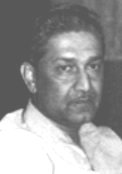
Dr. Abdul Qadeer
Khan in 1993
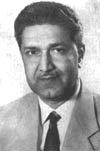
204x408, 12 K



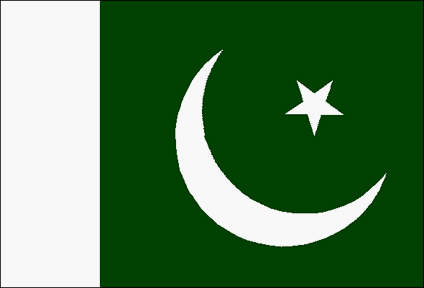

Last changed 2 January 2002
By Carey Sublette
Long celebrated as the "Father of the Pakistani Bomb", A. Q. Khan deserves credit for providing Pakistan with the means for producing nuclear weapons, for without the uranium enrichment gas centrifuge plant built under Khan's leadership, using classified and proprietary plans and technology that he stole from his former employer URENCO, Pakistan would not now have the ability to build dozens of nuclear weapons. He has spent most of the last quarter century as the public face, indeed the very personification, of Pakistan's nuclear establishment. His frequent willingness to make colorful and inflammatory public statements ensured his notoriety and hold on the limelight, up until his surprise forced retirement in March 2001. But much of the credit he has been awarded - and has done nothing to discourage - for being virtually the sole force behind Pakistan's nuclear and missile programs is not deserved.
 Dr. Abdul Qadeer Khan in 1993 |
 204x408, 12 K |
The hero of Pakistan's nuclear weapons capability was born in present day India, in Bhopal State, in 1936 - the son of a teacher in a family of modest means. For five years, between the 1947 establishment of India as an independent state and 1952, Khan was a citizen of India. Then the Muslim Khan immigrated to Pakistan with his family as did millions of other Muslims before and after the 1947 partition of the two states. After graduating from school in Karachi he went to Europe in 1961 to continue his studies. First in Germany he attended the Technische Universitšt of West Berlin, then in Holland where he received a degree in metallurgical engineering at the Technical University of Delft in 1967. Eventually Khan received a Ph.D. in metallurgy from the Catholic University of Leuven in Belgium in 1972.
After graduation Khan went to work for the Physical Dynamics Research Laboratory (FDO), a subsidiary of Verenigde Machine-Fabrieken, in Amsterdam in May 1972. FDO was a subcontractor to Ultra-Centrifuge Nederland (UCN) - the Dutch partner of the tri-national European uranium enrichment centrifuge consortium URENCO, made up of Britain, Germany, and the Netherlands.
Since Khan had lived in Europe from 1961 on and was married to a Dutch national (as the Dutch security service BVD believed) the very personable Khan had little trouble getting a security clearance - a limited security clearance. Curiously Khan's wife Henny was not Dutch though, but a Dutch-speaking South African holding a British passport.
Elementary principals of security were not, it seems, observed by any part of the URENCO establishment. Routine procedures, such as wearing identification badges marked with the level of clearance appear to have been unknown. Once someone gained access to part of a facility with one level of clearance, there seem to have been few if any barriers to moving to higher level areas. The customary practice of checking the security clearance level of a person before signing out to classified documents to them appears to have been ignored.
Within a week of starting with FDO A. Q. Khan was sent to the UCN enrichment facility in Almelo, Netherlands. A visit to an external facility would normally require the transmittal of security paperwork to be granted access. This procedure was ignored by both FDO and UCN, because Khan was not cleared to visit the UCN facility, though he would do so repeatedly during his employment.
The multi-lingual engineer was tasked with translating highly classified technical documents describing the centrifuges in detail. In the course of this work, he often took the documents home, with FDO's consent, even though this was also a breach of normal procedure. In his first two years Khan worked with two early centrifuge designs, the CNOR and SNOR machines, then in late 1974 UCN asked Khan to translate highly classified design documents for two advanced German machines, the G-1 and G-2. These represented the most sophisticated industrial enrichment technology in the world at the time.
Khan spent 16 days over the course of a month in the highest security area of the Almelo facility while studying these machines. During this period he had unsupervised access, and was noted roaming around, writing notes in a foreign script, but with the lax security culture no attempts to stop him or investigate his activities [Weissman and Krosney 1981; pp. 175-179], [Burrows and Windrem 1994; pp. 362-364].
Shahid-ur-Rehman relates in his book The Long Road to Chagai that Khan wrote to the Prime Minister in September 1974 offering his services to Pakistan, which means that he had definitely begun his espionage activities by the time he went to work with the G-2 and G-2. Evidence of the effect of Khan's passing of information on centrifuge technology and design, and on the URENCO component suppliers, to Pakistan can be seen in the initiation of the Pakistani purchase of components for the uranium enrichment program beginning in August 1975.
In January 1976, on (according to Khan) the invitation of Prime Minister Zulfikar Ali Bhutto, he suddenly left Europe with his family before his espionage was detected. The Khans's departure was deceptive, Henny wrote to neighbor's saying they were on vacation and Abdul had suddenly fallen ill. Khan later sent a letter of resignation, effective in March, to FDO from Pakistan.
A.Q. Khan initially worked under the Pakistan Atomic Energy Commission (PAEC), headed by Munir Ahmad Khan. A small centrifuge pilot facility was initially set up at Sihala, several kilometers southeast of Islamabad. Friction quickly developed and in July 1976 Bhutto gave Khan autonomous control of the uranium enrichment project, reporting directly to the Prime Minister's office, an arrangement that has continued since. A.Q. Khan founded the Engineering Research Laboratories (ERL) on 31 July 1976, a few kilometers from Sihala, outside Kahuta near Islamabad, with the exclusive task of indigenous development of Uranium Enrichment Plant. Construction on Pakistan's first centrifuges began that year. The PAEC under M. A. Khan went on to develop Pakistan's first generation of nuclear weapons in the 1980s [Perkovich 1999; pp. 308-309].
Due to Khan's efforts, the slow recognition of the program by western intelligence, and the weak export controls at the time, Pakistan made rapid progress in developing U-235 production capability. When export controls on nuclear usable materials were imposed on Pakistan in 1974, the focus was on technology applicable to plutonium production, not uranium enrichment, and the focus was on plants and complete systems, not components. By using Khan's detailed information of components and suppliers Pakistan was able to circumvent these controls.
According to Khan in a 1998 interview, the first enrichment was done at Kahuta on 4 April 1978. The plant was made operational in 1979 and by 1981 was producing substantial quantities of uranium.
In recognition of A. Q. Khan's contributions the ERL was renamed the A.Q. Khan Research Laboratories (KRL) by President Zia ul-Haq on 1 May 1981.
A later Dutch security enquiry revealed that Khan had probably appropriated much of the UCN facility's secrets. Starting in 1978, he was also named in numerous other Western inquiries and media reports about secret purchasing operations for components for Pakistan's uranium enrichment plant.
Khan acknowledges he did take advantage of his experience of many years of working on similar projects in Europe and his contacts there with various manufacturing firms, but denies engaging in nuclear espionage for which a court in Amsterdam sentenced him in absentia in 1983 to four years in prison. An appeals court two years later upheld his appeal against the conviction and quashed the sentence for failure to properly deliver a summons to him.
The prosecution had the option to renew the charges and issue a fresh summons for trial, but given the impossibility of serving him a summons behind the curtain of Pakistani security the Dutch government decided against pursuing the case any further - a fact that Khan claims as an admission that there was no substance to the case.
"The information I had asked for was ordinary technical information available in published literature for many decades," Khan said in a speech afterwards about his two letters to his contacts that became the basis for his prosecution.
"I had requested for it as we had no library of our own at that time."
Of course the classified documents he undoubtedly copied and sent to Pakistan, as well as his written notes were not in the possession of Dutch security and thus could not be used to build a case against him.
Khan insists that the Pakistani centrifuge program is indigenous and that the equipment used in it was developed and manufactured locally. In 1990 Khan declared "All the research work was the result of our innovation and struggle. We did not receive any technical know-how from abroad, but we can't reject the use of books, magazines and research papers in this connection." [Burrows and Windrem 1994; pp. 368]
It has been reported that a CIA analyses of Pakistan's huge purchasing program showed that they had succeeded in obtaining at least one of almost every component needed to build a centrifuge enrichment plant [Weissman and Krosney 1981; pp. 190].
The notion - expressed by Khan - that his personal access to detailed classified and proprietary ultracentrifuge designs was coincidental to his role in leading Pakistan's enrichment program, that he declined to employ the knowledge he had gained at FDO to assist Pakistan's program in constructing an enrichment plant in five years, and that the wholesale importation of the entire technology suite required to build a European-designed centrifuge plant does not constitute "technical know-how from abroad" cannot be taken seriously, to say the least.
The massive purchases of foreign equipment - continuing up through the purchase of ring magnets from China in the mid-90s, show heavy dependence on foreign technology and components. But even so, the plants themselves are Pakistani developments -- Pakistan had to design and build the facilities, assemble the systems from components, while manufacturing components themselves that they could not obtain in sufficient number. This is quite unlike reactors and plutonium separation plants that other proliferating countries have acquired ready-made and were trained to operate by their suppliers.
Khan, because of the secrecy enveloping Pakistan's nuclear program, has lived heavily guarded by security men. Over the years there have been a number of incidents involving encounters between foreigners and the heavy-handed security surrounding Khan and KRL. In late July 1979, unidentified men stopped and beat severely the French Ambassador and his First Secretary as they were driving by Khan's laboratories in Kahuta. A few weeks later in August a journalist for the Financial Times named Chris Sherwell trying to locate Khan's house to conduct an interview in Islamabad was beaten up and then arrested and charged with fictitious crimes, forcing him to leave the country. Later a British diplomat's son was detained by police after losing his way in the Islamabad district that houses Khan [Weissman and Krosney 1981; pp. 193], [Henderson 1993].
Despite the secrecy and security, Khan has taken the public spotlight on numerous occasions, attracting some criticism for seeking publicity in contrast to his more discrete counterpart in India, Abdul Kalam.
It was on such an occasion - an interview in February 1984 - that he first made the claim that Pakistan had achieved nuclear weapons capability.
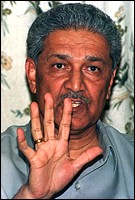 A. Q. Khan talking to journalists on 31 May 1998 after the second nuclear test. |
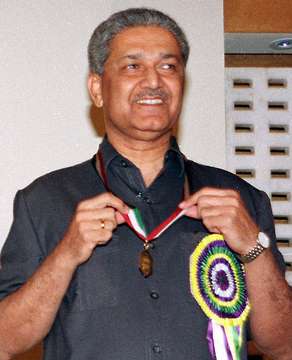 A. Q. Khan displaying his gold medal awarded by Pakistani President Rafiq Tarrar in Lahore after the 1998 tests. |
| Read Khan's interview with The News given after the tests. |
And when the 1986-87 Exercise Brasstacks crisis was at its height on 28 January 1987 - an outbreak of warfare between India and Pakistan seemed imminent due to a confrontation over military exercises near the border - A.Q. Khan made threatening remarks regarding Pakistani nuclear retaliation to Indian journalist Kuldip Nayar, apparently intending that they be conveyed to the Indian government. Nayar however shopped the story around for a few weeks, and it was not published until 1 March, after the matter had been resolved. Nonetheless it left a lingering sense of nuclear threat with India.
Khan's public pronouncements also helped generate the tense atmosphere in which India's 1998 nuclear tests were conducted. In an inauspiciously timed visit, Bill Richardson led a high level U.S. delegation that visited New Delhi and then Pakistan on 15 April. During the visit Khan, told the Urdu daily Ausaf "We are ready to carry out nuclear explosion anytime and the day this political decision will be made, we will show the world," during an informal chat with journalists. "We have achieved uranium enrichment capability way back in 1978 and after that several times we asked different governments to grant us permission to carry out a nuclear test. But we did not get the permission," the daily quoted him as saying. Asked when Pakistan would carry out a nuclear test, Dr. Khan was quoted as having said, "Get permission from the government." Khan was not a spokesman for the government at the time, but he remained extremely influential and was still closely connected with the corridors of power in Pakistan.
As a result, not everyone in Pakistan holds Khan in awe. Some who have worked with him remember him as a egomaniacal lightweight given to exaggerating his expertise. "Most of the scientists who work on weapons are serious. They are sobered by the weight of what they don't know," said Munir Ahmad Khan, the former head of the PAEC. "Khan is a showman."
Despite his extreme prominence (Khan is one of the most famous men in Pakistan) and undoubted importance in Pakistan's acquisition of nuclear weapons, A. Q. Khan was never in charge of the actual development of nuclear weapons themselves (despite common assumptions to the contrary, which Khan did nothing to discourage). Weapons development, and their eventual testing, was carried out by the PAEC.
During the 1990s Khan lived in a spacious single-story house, located in Islamabad near the Faisal mosque, with his wife Henny and two daughters. The road outside his house is a public thoroughfare, but there are safety bumps in the road surface to slow traffic and a permanent security post is opposite the house. On the road, his car is escorted by four-wheel drive security vehicles with sirens and lights blaring and flashing.
Khan keeps a small menagerie of pets. Each day at sunrise, he takes a sackful of peanuts when he walks into the wooded Margala Hills across from his home and feeds the monkeys. Declared Khan, the day after his country exploded another nuclear device, "I am the kindest man in Pakistan. I feed the ants in the morning. I feed the monkeys."
Abdul Qadeer Khan's official career came to an abrupt end in March 2001, when he and PAEC Chairman Ishfaq Ahmed were suddenly retired by order of General (and now President) Pervez Musharraf. What prompted this move can only be speculated, but the Pakistani weapons program - which has been sponsored, run, and controlled by the military from its outset - is now mature, and it may be that Musharraf, who was busy mending fences with the outside world, wished to tie down some loose cannons that were a source of irritation with India and the United States. Both men were offered the post of "adviser to the chief executive", which Khan eventually rejected after much vacillation. Khan is now described as "Special Adviser to the Chief Executive on Strategic and KRL Affairs" a wholly ceremonial title. ([Mushtaq 2001], [Guinnessy 2001]).
Reuters and Los Angeles Times news reports were used in preparing this article.